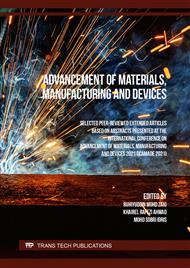[1]
S. K. Nune, K. S. Rama, V. R. Dirisala, and M. Y. Chavali, Electrospinning of collagen nanofiber scaffolds for tissue repair and regeneration, Micro and Nano Technologies, (2017) 281-311.
DOI: 10.1016/b978-0-323-46142-9.00011-6
Google Scholar
[2]
A. Leonés, M. Lieblich, R. Benavente, J. L. Gonzalez, and L. Peponi, Potential applications of magnesium-based polymeric nanocomposites obtained by electrospinning technique, Nanomaterials, 10 (2020) 1–33.
DOI: 10.3390/nano10081524
Google Scholar
[3]
A. Najafi, A novel synthesis method of nanostructured MgO-coated hollow carbon nanofibers via CO decomposition over Mg/MgO catalyst, Ceram. Int., 43 (2017) 9220–9225.
DOI: 10.1016/j.ceramint.2017.04.076
Google Scholar
[4]
C. Heuer, E. Storti, T. Graule, and C. G. Aneziris, Electrospinning of Y2O3 and MgO stabilized zirconia nanofibers and characterization of the evolving phase composition and morphology during thermal treatment, Ceram. Int., 46 (2020) 12001–12008.
DOI: 10.1016/j.ceramint.2020.01.240
Google Scholar
[5]
C. Xu et al., High-temperature stable electrospun MgO nanofibers, formation mechanism and thermal properties, Ceram. Int., 43 (2017) 16210–16216.
DOI: 10.1016/j.ceramint.2017.08.199
Google Scholar
[6]
T. Baysal, N. Noor, and A. Demir, Nanofibrous MgO composites: structures, properties, and applications, Polym. Technol. Mater., (2020) 1–30.
Google Scholar
[7]
J. Hornak et al., Magnesium oxide nanoparticles: Dielectric properties, surface functionalization and improvement of epoxy-based composites insulating properties, Nanomaterials, 8 (2018) 1–17.
DOI: 10.3390/nano8060381
Google Scholar
[8]
A. Manuscript, Mesoporous MgO/PPG Hybrid Nanofibers: Synthesis, Optimization, Characterization and Heavy Metal Removal Property, (2017).
Google Scholar
[9]
M. M. M. G. P. Gayanath, R. T. De Silva, and S. P. Ratnayake, Photocatalytic activity of electrospun MgO nanofibers: Synthesis, characterization, and applications, Mater. Res. Bull., 99 (2018) 204–210.
DOI: 10.1016/j.materresbull.2017.10.047
Google Scholar
[10]
Y. Guo et al., Nanostructured MgO Sorbents Derived from Organometallic Magnesium Precursors for Post-combustion CO2 Capture, Energy and Fuels, 32 (2018) 6910–6917.
DOI: 10.1021/acs.energyfuels.8b00866
Google Scholar
[11]
S. Thenmozhi, T. Krishnaveni and K. Kadirvelu, Reduction of nitro compounds in aqueous medium using electrospun MgO nanofibers, Materials Research Express, 6 (2019).
DOI: 10.1088/2053-1591/ab0b05
Google Scholar
[12]
V. A. Online, A novel porous MgO sorbent fabricated through carbon insertion, 4 (2014) 12014–12022.
Google Scholar
[13]
C. Tan et al., Structurally improved MgO adsorbents derived from magnesium oxalate precursor for enhanced CO2 capture, Fuel, 278 (2020) 118379.
DOI: 10.1016/j.fuel.2020.118379
Google Scholar



